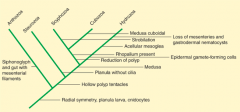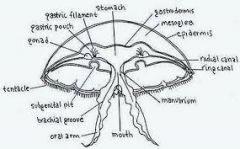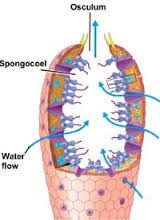![]()
![]()
![]()
Use LEFT and RIGHT arrow keys to navigate between flashcards;
Use UP and DOWN arrow keys to flip the card;
H to show hint;
A reads text to speech;
14 Cards in this Set
- Front
- Back
|
What are the five classes of cnidarians and their identifying characteristics? |

|
|
|
What phylum do sea sponges belong to? |
Porifera |
|
|
What is a choanocyte, what is it for? |
Are cells that line the interior of asconoid, syconoid and leuconoid body type sponges that contain a central flagellum, or undulipodia, surrounded by a collar of microvilli which are connected by a thin membrane. They make up Choanoderm, a type of cell layer found in sponges. |
|
|
What is a spicule? What is for? Where are they made? |
Some spicules are formed of the mineralized substances calcium carbonate and silica, while others are made of an organic substance called spongin. Spongin skeletons were and are used as scrubbers in bathtubs, though they are fairly expensive. |
|
|
What 3 cell types make up a sponge? |
Choanocytes (also known as "collar cells"), flagellated cells which function as the sponge's digestive system, are remarkably similar to the protistan choanoflagellates. The collars are composed of microvilli and are used to filter particles out of the water. |
|
|
What phylum are sea walnuts a member of? |
Mnemiopsis |
|
|
What are the comb rows in ctenophora for? |
Special cilia in the mouth are used for biting gelatinous prey |
|
|
What is the life cycle of a cnidarian? |
one to thirty years old |
|
|
What is a planula? |
A free-swimming coelenterate larva with a flattened, ciliated, solid body. |
|
|
What is a nematocyst? Cnidocyst? |
Nematocyst-a specialized cell in the tentacles of a jellyfish or other coelenterate, containing a barbed or venomous coiled thread that can be projected in self-defense or to capture prey. Cnidocyst- is an explosive cell containing one giant secretory organelle or cnida that defines the phylum Cnidaria. |
|
|
Are cnidarians sexual or asexual, explain? |
They are asexual. They release eggs which develop into polyps and grow from there. |
|
|
Differences in gastrodermis/epidermis. |
epidermis is the outer skin and gastrodermis is the inner skin |
|
|
Sketch a simple drawing and identify the structures of Aurelia. |

|
|
|
Sketch a simple drawing and identify the structures of a sponge. |

|

